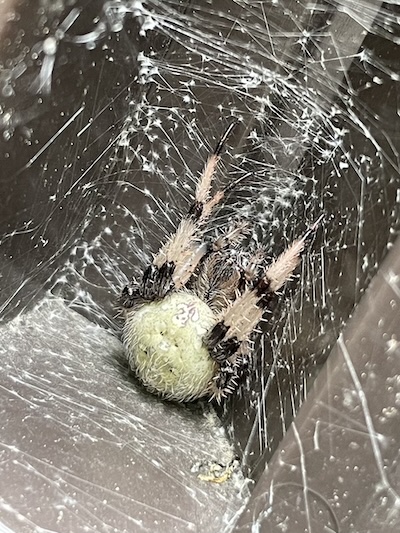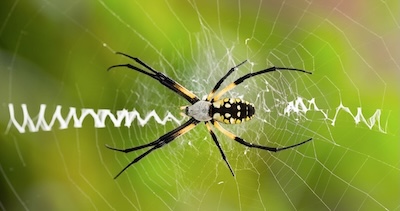Araneidae: Difference between revisions
No edit summary |
No edit summary |
||
| Line 38: | Line 38: | ||
Orb-weaver spiders are often identified by their brightly colored / patterned bodies. Araneidae have rounded abdomens that are used for storing food and producing silks. They also have characteristically elongated legs that aid in maneuvering across their webs. Near the bottom of the orb-weaver's abdomen, there are spinnerets present. Spinnerets are specialized organs that produce the silk threads for web constructions. Orb-weavers typically have three pairs of spinnerets, each having a specific job in the creation of the orb-weaver’s intricate webs. Orb-weavers vary greatly in size; large species of Orb-weavers can average 1-5 inches in size, while smaller species of Orb-weavers can average 1-8 centimeters in size. | Orb-weaver spiders are often identified by their brightly colored / patterned bodies. Araneidae have rounded abdomens that are used for storing food and producing silks. They also have characteristically elongated legs that aid in maneuvering across their webs. Near the bottom of the orb-weaver's abdomen, there are spinnerets present. Spinnerets are specialized organs that produce the silk threads for web constructions. Orb-weavers typically have three pairs of spinnerets, each having a specific job in the creation of the orb-weaver’s intricate webs. Orb-weavers vary greatly in size; large species of Orb-weavers can average 1-5 inches in size, while smaller species of Orb-weavers can average 1-8 centimeters in size. | ||
[[File:Orb-weaver spider web.jpg|401px|thumb|Center of Golden Orb-weaver spider web]] | [[File:Orb-weaver spider web.jpg|401px|thumb|Center of Golden Orb-weaver spider web [8]]] | ||
==Webbing Habits== | ==Webbing Habits== | ||
Orb-weaver spiders (family Araneidae) are known for their intricate, wheel-shaped webs, which they construct using a highly methodical process. Web building typically begins with the spider releasing a silk thread that catches onto a surface via the wind, forming a bridge line. The spider then reinforces this initial line and descends to create a Y-shaped framework, which serves as the base of the web. It continues by constructing radial spokes outward from a central hub, much like the spokes of a bicycle wheel. Next, the spider lays down a temporary spiral from the center outward to space the radial lines, followed by the final sticky capture spiral, which it builds inward toward the hub. This spiral is coated with adhesive droplets to trap prey. Most orb-weavers rebuild their webs daily, usually at dusk or dawn, and consume the old silk to recycle its proteins. [5] | Orb-weaver spiders (family Araneidae) are known for their intricate, wheel-shaped webs, which they construct using a highly methodical process. Web building typically begins with the spider releasing a silk thread that catches onto a surface via the wind, forming a bridge line. The spider then reinforces this initial line and descends to create a Y-shaped framework, which serves as the base of the web. It continues by constructing radial spokes outward from a central hub, much like the spokes of a bicycle wheel. Next, the spider lays down a temporary spiral from the center outward to space the radial lines, followed by the final sticky capture spiral, which it builds inward toward the hub. This spiral is coated with adhesive droplets to trap prey. Most orb-weavers rebuild their webs daily, usually at dusk or dawn, and consume the old silk to recycle its proteins. [5] | ||
| Line 68: | Line 68: | ||
[7] Rosmarino, Gill. Shamrock Orb-weaver Full Body. 26 July 2022. Author's Personal Collection | [7] Rosmarino, Gill. Shamrock Orb-weaver Full Body. 26 July 2022. Author's Personal Collection | ||
[8] Smith, Barbara H. “Beneficial Yellow Garden Spiders.” Home & Garden Information Center, 2020, hgic.clemson.edu/beneficial-yellow-garden-spiders/. | |||
| |||
Revision as of 14:41, 30 April 2025
Overview
Araneidae, orb-weaver spiders, are the largest group of orb-web-building spiders. The Araneidae family currently has 3,152 species and is the third largest family of spiders after Salticidae (Jumping spiders) and Linyphiidae (Sheet weaver spiders). [1]
Orb-weaver spiders (Araneidae) are known for their distinctive wheel-shaped webs. Common species include the yellow garden spider (Argiope aurantia), known for its striking black and yellow coloring, and the European garden spider (Araneus diadematus), easily recognized by the white cross-shaped markings on its back. Orb-weavers are generally non-aggressive and beneficial for pest control. In media, one of the most famous depictions is Charlotte from Charlotte’s Web by E.B. White, who is portrayed as a wise and kind orb-weaver spider, specifically modeled after a Barn Spider (Araneus cavaticus). Her character helped shape a positive public perception of spiders.
 | |
| Domain: | Eukaryota |
|---|---|
| Kingdom: | Animalia |
| Phylum: | Arthropoda |
| Subphylum: | Chelicerata |
| Class: | Arachnida |
| Order: | Araneae |
| Infrarder: | Aranemorphae |
| Family: | Araneidae |
Description
Orb-weaver spiders are often identified by their brightly colored / patterned bodies. Araneidae have rounded abdomens that are used for storing food and producing silks. They also have characteristically elongated legs that aid in maneuvering across their webs. Near the bottom of the orb-weaver's abdomen, there are spinnerets present. Spinnerets are specialized organs that produce the silk threads for web constructions. Orb-weavers typically have three pairs of spinnerets, each having a specific job in the creation of the orb-weaver’s intricate webs. Orb-weavers vary greatly in size; large species of Orb-weavers can average 1-5 inches in size, while smaller species of Orb-weavers can average 1-8 centimeters in size.

Webbing Habits
Orb-weaver spiders (family Araneidae) are known for their intricate, wheel-shaped webs, which they construct using a highly methodical process. Web building typically begins with the spider releasing a silk thread that catches onto a surface via the wind, forming a bridge line. The spider then reinforces this initial line and descends to create a Y-shaped framework, which serves as the base of the web. It continues by constructing radial spokes outward from a central hub, much like the spokes of a bicycle wheel. Next, the spider lays down a temporary spiral from the center outward to space the radial lines, followed by the final sticky capture spiral, which it builds inward toward the hub. This spiral is coated with adhesive droplets to trap prey. Most orb-weavers rebuild their webs daily, usually at dusk or dawn, and consume the old silk to recycle its proteins. [5]
Orb-weaver spiders are strategic about web placement, typically building in open spaces between branches, across paths, or near lights where flying insects are abundant. They often select locations with minimal wind and sufficient anchor points to support the web’s radial structure. The position also varies by species—some prefer low vegetation, while others suspend their webs high in the canopy or on man-made structures. The goal is to maximize prey capture while minimizing damage from environmental factors. [3]
Web rebuilding is common and serves several purposes. These spiders usually dismantle and consume their webs daily, often in the early morning or evening, to reclaim the silk proteins, which are energetically costly to produce. Environmental wear, dust accumulation, and reduced stickiness also degrade a web’s effectiveness over time. Rebuilding ensures the web remains optimally positioned and fully functional for catching prey. Additionally, by varying web position slightly each day, orb-weavers may avoid becoming predictable to predators or parasitic insects that exploit stable web sites. [4]
Reproduction
Araneidae have interesting reproductive behaviors. In many species, males are much smaller than females and must approach carefully to avoid being eaten, as females can mistake them for prey. Mating usually involves some form of courtship, like vibrations on the web, which helps the female recognize the male as a mate instead of food. After mating, some males are eaten by the female—a behavior known as sexual cannibalism, which may help by giving the female extra nutrients for her eggs. Females lay eggs in silk sacs and often hide or guard them until they hatch. These strategies help ensure that at least some of their offspring survive in the wild. [6]
Taxonomy
The family Araneidae falls within the order Araneae and the suborder Araneomorphae, a group that encompasses the majority of modern spiders. Members of Araneidae vary widely in morphology and coloration, yet they are unified by their ability to construct the characteristic circular orb webs used for prey capture. Prominent genera within the family include Araneus, Argiope, and Gasteracantha. Advances in both morphological and molecular techniques have continued to refine the taxonomy of this diverse group, shedding light on their evolutionary relationships with other web-building spiders
References
[1] Bern, Museum. “NMBE - World Spider Catalog.” Nmbe.ch, 2025, wsc.nmbe.ch/statistics/.
[2] “Orb Weaver Spider Control: Facts, Control & Tips – Aptive Environmental.” Aptive Environmental, 31 Aug. 2024, aptivepestcontrol.com/pests/spiders/orb-weaver-spiders/orb-weaver-spider-control-facts-control-tips/#:~:text=One%20of%20the%20defining%20characteristics,giving%20them%20an%20unmistakable%20appearance.
[3] “How Do Spiders Choose Where to Spin Their Webs?” Assured Environments, 5 Sept. 2024, www.assuredenvironments.com/blog/how-do-spiders-choose-where-to-spin-their-webs/.
[4]Taras, Zach. “The Orb Weaver Spider Consumes Its Own Used Webs.” HowStuffWorks, 14 Jan. 2025, animals.howstuffworks.com/arachnids/orb-weaver-spider.htm?.
[5] Eberhard, William G. “Behavioral Characters for the Higher Classification of Orb-Weaving Spiders.” Evolution, vol. 36, no. 5, Oxford University Press (OUP), Sept. 1982, p. 1067, https://doi.org/10.2307/2408084.
[6] Schneider, Jutta, and Maydianne Andrade. “Mating Behaviour and Sexual Selection.” Spider Behaviour, Cambridge University Press, Jan. 2011, pp. 215–74, https://doi.org/10.1017/cbo9780511974496.008.
[7] Rosmarino, Gill. Shamrock Orb-weaver Full Body. 26 July 2022. Author's Personal Collection
[8] Smith, Barbara H. “Beneficial Yellow Garden Spiders.” Home & Garden Information Center, 2020, hgic.clemson.edu/beneficial-yellow-garden-spiders/.